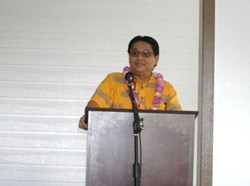By Jan Wizinowich
 Honokaʽa Senior Musicians
Honokaʽa Senior Musicians  Kaye Lundberg
Kaye Lundberg  Representative Mark Nakashima
Representative Mark Nakashima  Momi Naughton
Momi Naughton The added depth of the exhibit comes from the many quotes that invite the reader into a world and a life, long past, but still very much a part of the nature of the plantation communities. “I chose these quotes from oral histories because I think they really, really speak to how it felt growing up small kid time on the plantation, as well as how people felt when the plantation closed. There’s some very poignant photographic images and some very poignant quotes. Coming into the exhibit there’s a quote I selected, which was written in a book called Sugar Town by Scotch Kurisu.”
Up and down the Hilo coast people are looking ahead, trying to figure out what comes next after sugar. But this is also a time for looking back at where we’ve been and how far we’ve come. Sure we raised productive sugar cane, but we also raised children and grandchildren of fine stock and good character. New generations who have built on their plantation heritage, more than anything else they are the real legacy of the sugar towns.
 Bill Garcia, John and Ann Bowen
Bill Garcia, John and Ann Bowen Although the spark of the idea came from the experiences and talents of John and Ann, as often is the case here, there were many people with aloha who encouraged and helped the Bowens along the way. “Initially we wrote a letter to Yoshita Takamine at the ILWU and proposed the idea to him. And very shortly after mailing the letter we got a phone call, ‘Please come meet with me’. He overwhelmingly supported the idea and he was the initial person who opened a lot of doors for us that otherwise we wouldn’t be able to open….Very quickly after that we met Joe Garcia and he was just a fantastic person, who helped us immensely. We got to meet his dad on Maui because he belonged to the statewide project.” Joe Garcia’s son, Bill a Big Island rancher and musician was an honored guest.
In a world looking towards survival based on sustainability practices, it will be necessary to do more with less and to create interdependent communities and the plantation lifestyle was an exemplar of this. The next speaker, Valerie Poindexter, grew up on the plantation; her experiences and memories contribute to an outlook that bodes well for the future. “When I saw the pictures in the Tribune Herald, one of them was of our home and that brought so many memories back. What did I get out of growing up in a plantation camp? When we were growing up and we were little children, we didn’t see anything special because the whole island was plantation camp so there was nothing different. There were no big subdivisions; that to us was unheard of. All the politicians today are talking about sustainability and they just got to come back and look at the plantation lifestyle.”
 Valerie Poindexter
Valerie Poindexter This was not an impoverished lifestyle, but one that was rich with natural resources and a close community of people. “Life was very simple back then. When we grew up we were poor and yet we didn’t know we were poor because we were happy. Back then in the camps as children, what did we have to play with? We had guava sticks and your imagination just had to run wild so you could have a lot of fun. The guys would make sling shots out of the guava sticks and the girls, you know I had a wand, I was the fairy princess; I would turn the pear tree into my boyfriend. We were a huge community. It’s really amazing this multi-cultural society that was created. Someone came from the mainland a couple of days ago and he said, ‘When you land on the island, you just feel this ahhhhh’. And that’s how we are and I think living in that lifestyle in that multicultural society how we live together in communities is the true aloha spirit.”
This exhibit is also a testament to the aloha spirit that is still alive because the kupuna, the elders have passed on the wisdom that comes with hard work and loving kindness. “We survived because we had each other. You’ve heard that African proverb, ‘It takes a village to raise a child’ and that should have been our proverb, because that’s actually what it took. I look at Farrah sitting here and all the accomplishments and her grandpa sitting here. It brings about a lot of history and a lot of who we are. Sometimes the children in school, they have no clue who they are. I look at all the kupuna’s sitting here and I want to cry because it’s because of what you gave us that we are who we are today and that’s the true aloha spirit. I have a lot of gratitude for what you have done for us.”
 Farrah Gomes
Farrah Gomes  RSS Feed
RSS Feed
